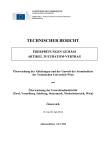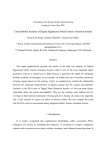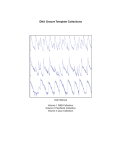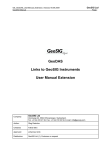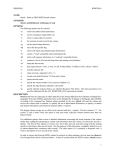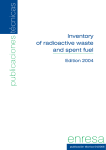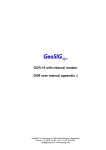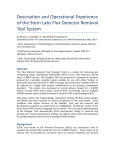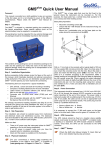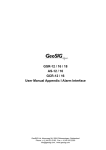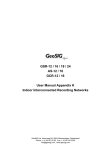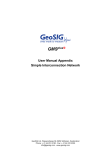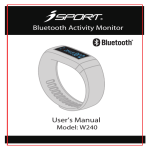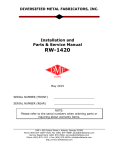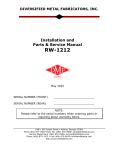Download Seismic Monitoring System for Nuclear Power Plants
Transcript
Seismic Monitoring System for Nuclear Power Plants CONTENT Overview ...................................................................................................................................................... 03 System Centre.............................................................................................................................................. 04 Recorders ..................................................................................................................................................... 13 Sensors ........................................................................................................................................................ 18 Example System .......................................................................................................................................... 27 Reference List .............................................................................................................................................. 29 Company Presentation ................................................................................................................................. 32 INTRODUCTION According to regional, national and international regulations, Nuclear Power Plants (NPP) need to be able to mitigate potential effects of an earthquake. Such mitigation can be achieved by utilising specific instrumentation for monitoring the earthquake ground motions and the response of the plant features to these motions. This type of instrumentation is called Seismic Monitoring System (SMS). Main functions of the SMS are: • Detection of any (significant) earthquake at plant location • Provide data records of acceleration at defined locations • Perform OBE/SSE exceedance evaluation • Provide a report to the plant operator after an event • Periodical self test execution GeoSIG delivers complete SMSs for the NPP applications. These systems; • Comply fully or exceed regional, national and international nuclear regulatory requirements • Come with comprehensive certification and documentation, which can as well be supplied from scratch for any particular requirement. • Include powerful industrial computer for complex data processing based on different algorithms including response spectra analysis • Perform automatic analysis and evaluation of the earthquake impact on monitored structures • Provide comprehensive and fast notification and reporting features • Warrant the robustness, reliability and functionality to serve it main purpose • Include self diagnostic and testing features to assure continuous system readiness to act once in a life • Present simplicity of operation, maintenance and upgrade This document provides an overview of the SMS supplied by GeoSIG. Upon request several more detailed documents are available, such as: Sample Operator Report Sample Design Report Qualifications and Certificates Regulatory Compliance Reference Letters Detailed Technical Notes on Example Systems Terms and Conditions OVERVIEW The core of the GeoSIG Seismic Monitoring System (SMS; or SAS for Alarm System) is a Central Processing Unit (CPU) rack mounted in a seismically and EMC safe cabinet together with an industrial PC and relevant peripherals. Detection / Recording Units (DRU's) consisting of accelerometers, seismometers or complete seismic station packages are placed at remote locations that are connected to the CPU through shielded copper or fibre optic cables. The system has been designed in a way that it is not bound to a single topology. There could be only the sensors or both sensors and data acquisition out in the field. GeoSIG, unlike any other supplier, can offer three different and versatile solutions for the seismic instrumentation of Nuclear Power Plants. One is the Decentralised System, where each measuring point has a seismic sensor together with a dedicated recorder and there is a system central controlling the overall operation and providing system intervention and maintenance. Second one is the Centralised System where only the seismic sensors are located at the measuring points and all other functionality are provided by the system central. And finally the Cascaded System, which is a combination of the decentralised and centralised systems to provide a more flexible deployment. The system provides high modularity and flexibility so that an upgrade is simplified and that as much as possible existing elements can be reused. State of the art GeoDAS software is utilized in the CPU. GeoDAS monitors all DRU's in parallel, as a result of the dedicated serial communication links that are provided by the system hardware. For each measuring channel the recording threshold and the alarm limit values can be set individually. Detailed response spectrum limits can be fully defined along with other parameters as required by relevant regulations or customized user requirements. Continuously monitoring the DRU's, the CPU detects seismic events, generates associated alarms and automatically processes the recorded data. It performs periodical tests on the system and monitors the system-wide state of the health as well as analyses the detailed cause of any malfunction. A fully automated Detailed Operator Report is provided a few minutes after the occurrence of an earthquake. SYSTEM CENTRE SMS, Seismic Monitoring / Alarm System GeoDAS Software GeoSIG Ltd Wiesenstrasse 39 8952 Schlieren Switzerland Tel: Fax: E-mail: Web: +41 44 810 21 50 +41 44 810 23 50 [email protected] www.geosig.com SMS / SAS Seismic Monitoring / Alarm System Features* Recording, advanced analysis and annunciation according to project specific or international regulations Automatic exceedance evaluation Reporting and alerting via relays, visual and audible tools as well as printed matter Project specific Automatic Event Processing (AEP), Nuclear (NPP) or other features Upto 48 remote stations or sensors 20 to 24-bit event based and/or continuous recording Common timing and triggering within the system Completely over-voltage protected Continuous system-wide SOH monitoring Seismically and EMC proven design Comprehensive configuration of the whole system via the enhanced computer interface *The information provided is a typical overview. For each project a specific description is provided outlining the relevant system. Outline The core of the SMS / SAS is a Central Processing Unit The CPU monitors all DRU's in parallel, as a result of the (CPU) with a multi-channel digital recorder system rack dedicated communication links that are provided by the mounted in an industrial cabinet together with an industrial system hardware. computer and relevant peripherals. By monitoring continuously the DRU's, the CPU detects Accelerometers, seismometers, complete seismic stations seismic events, generates associated alarms and or sensor packages, which are referred to as Detection / automatically processes the recorded data. Also it Recording Units (DRU's) are placed at remote locations performs periodical tests on the system and monitors the can be connected to the CPU. system-wide state of the health as well as analyses the detailed cause of any malfunction. The result of the data The system has been designed in a way that it is not processing is provided in a report a few minutes after the bound to a single topology. There could be only the occurrence of an event. sensors or both sensors and data acquisition out in the field. Advantages of these topologies are briefly explained State of the art GeoDAS software is utilized in the CPU. in the specifications section. For each measuring channel the recording threshold and the alarm limit values can be set individually. Detailed The system has a great modularity and flexibility so that project limits can be fully defined along with other an instrumentation upgrade is simplified and that as much parameters as required by relevant regulations or as possible existing elements can be reused. customized user requirements. Specifications SMS / SAS Seismic Monitoring / Alarm System Centralized Recording De-centralized Recording Advantages: Simple devices in controlled area (analog sensors). Simplified diagnostics and maintenance. Higher compatibility with existing systems for upgrade. Advantages: Independent recording units increase redundancy and reliability. Link from remote to central can use Fiber Optics. Digital transmission between remote and central locations. Cascaded / Hybrid Recording Combination of the decentralised and centralised systems to provide a more flexible deployment. Typical System Specifications The below specifications provide a typical overview. For each project a specific description is provided outlining the relevant system. Sensor SMS/SAS system offers the most flexible sensor connectivity options to cater for the needs of any measuring requirement. Any matching type of sensor can be connected to the system. Digitiser A/D Converter: Dynamic Range: Sampling rates: Bandwidth: 20 to 24 bits 108 to 146 dB 100 to 500 SPS per channel 40% of sampling rate Data Recording Pre-event-Time: Post-event-Time: Adjustable * Adjustable * Triggering Type Filtering: Data Storage Type: Level (threshold) or STA/LTA trigger, project specific triggers also available User configurable 2 -128 Gbyte per 3 channels and/or HDD, SSD in the computer Data Analysis GeoDAS software provides various analysis functions like filtering, FFT, response spectra, etc. Other commercially available evaluation software packages may alternatively be used. Timing Standard clock accuracy: Free running, based on TCXO External time interfaces: GPS System accuracy < 1 sec. Indicators LED, Push button and/or Flatscreen indicators, may vary with each project, based on requirements Self Test / State of Health Permanently active, self monitoring and user selectable, periodical system test including comprehensive sensor, memory, filter, real time clock, battery level and hardware tests. Seismic Switch / Warning / Alarm Options The warning option provides independent warning / error outputs (relay contacts) based on user selectable criteria. As separate acquisition module in the CPU with its own power supply, remote sensor and cable; or independent DRU’s with integral relays and CPU connection. Communication Channel Options Ethernet TCP/IP, landline, GSM/ GPRS/UMTS/3G, Serial Power Supply AC/DC Power supply: External battery option: 230 VAC / 50 Hz or 115 VAC / 60 Hz Rechargeable, 12 VDC, 24 to 100 Ah Housing 19’’ cabinet in different sizes, floor standing or wall mounted. *: Any value is useable, as long as it does not lead to data loss because of incorrectly configured or conflicting parameters. Specifications subject to change without notice Copyright © GeoSIG Ltd, 03.03.2014/ GS_SMS-SAS_Leaflet_V07.doc GeoSIG Ltd Wiesenstrasse 39 8952 Schlieren Switzerland Tel: Fax: E-mail: Web: +41 44 810 21 50 +41 44 810 23 50 [email protected] www.geosig.com GeoDAS NPP Features Introduction This document summarizes the features and functionalities of the GeoDAS used in the NPP seismic Instrumentation Projects. This document is intended be studied together with other GeoSIG technical documents relating to NPP instrumentation to grasp the full context and the concepts mentioned. If supplied within the context of an NPP Seismic Monitoring System, a special version of GeoDAS software is delivered to be used to perform data analysis of the recorded time history, perform alarm and announcing if the analysis determines that the seismic event has exceeded software thresholds established by the structural engineers and operators of an NPP. Summary of Operation Site-specific parameters are set into the recorders in order to prepare the DRUs to detect and record any events. The event files are kept in the recorder memory, which is a flash memory card. As soon as new event occurs the relevant recorder settings like time, date, serial number, type of sensor and trigger level are attached to the data file are saved to the recorder’s memory. This event file will be automatically downloaded to the CPU computer. Further the event files are processed and analysed for Seismic, OBE and SSE checks. Further analysis is possible with the ODV feature under manual mode. GeoDAS NPP Features In normal operation mode of the system, the CPU downloads event files from each DRU automatically. At any time, a user can download any event recording manually by means of the Event Manager. The recorders operate according to the specified settings, even without being connected to the CPU computer, since the data is saved in the recorders memory. The system computer performs a Response Spectra Analysis (RSA) of the time domain record to determine the acceleration at the various frequencies. The structural SSE and OBE levels for the location of the accelerometer may be entered into the system and the RSA compared against the SSE and OBE levels established for each site. When the RSA analysis exceeded the SSE and OBE levels the computer will generate a software alarm to the GNC, which will in turn activate the Alarms that a SSE and/or OBE level has been exceeded. The system may also be set up to automatically print out the time history, RSA with OBE & SSE levels, Fast Fourier Transform (FFT) and Cumulative Absolute Velocity (CAV) on the HP laser printer. The OBE alarm (OBE exceedance) is a combination the calculated elements done by GeoDAS it can be one of the following combination: • • • • • CAV Only: Cumulated Absolute Velocity CAV and OBE PSA: Cumulated Absolute Velocity and Pseudo Spectral Acceleration OBE PSA Only: Pseudo Spectral Acceleration OBE PSA and OBE SV: Pseudo Spectral Acceleration and Spectral Velocity. CAV and OBE PSA and OBE SV: Cumulated Absolute Velocity and Pseudo Spectral Acceleration and Spectral Velocity Once the event data has been recorded in the individual Recording module it remains in the non-volatile flash memory until removed by an authorized operator. Once an event has occurred the event record will be automatically downloaded to the central system computer located in the central control panel where the GeoDAS software will automatically perform an analysis of the time history record. Within a few minutes the computer will have performed the preliminary analysis of the seismic event and if structural levels have been exceeded provide an appropriate alarm making the system fully compliant to the new NPP guideline and requirements. The alarm threshold levels may be individually set on each channel. The recording alarm threshold will cause the time domain recording of all acceleration signals exceeding the alarm threshold. Authorized structural engineers and managers have found it useful to access the computer via the LAN and download a particular event record for further analysis on their a computer at their desk. GeoSIG provides a site license for the use of the GeoDAS software package allowing the use of the analysis package on as many computers as the customer requires. GeoDAS allows limited and controlled access at various levels to maintain security and allow for the effective maintenance and operator control to the system. GeoSIG recommends that the customer establishes internal operating procedures for system test and maintenance including a procedure for copying and archiving event records. A Read/Write CD is provided for that purpose. The system performance, hard drive disc file space, computer memory and recording module non-volatile memory has been sized to satisfy the system requirements and provide reliable long-term operation. The software has two modes of operation: • • Standard, where the software is in the so-called “autodownload-mode”, downloading and analysing automatically any events Extended, where the user can stop the autodownload-mode and login to the DRUs manually Specifications subject to change without notice Copyright © GeoSIG Ltd, 25.06.2014/ GS_GeoDAS_NPP_Features_V06.doc GeoDAS NPP Features Seismic Check After an event is recorded the CPU computer will retrieve the recorded data from the DRUs for further analysis. Any reserve units will not be used for seismic check. Automatic analysis after retrieval of data in the computer will decide if the event is seismic or non-seismic. The decision whether an event is seismic or nonseismic is based on several tests listed below. Number 1 2 3 Table 1. Seismic / non seismic event detection Tests for ‘seismic event Non-seismic Event Seismic Event detection’ if… if… Number of DRU locations Only 1 recorder triggered 2 of 6 recorders triggered with recordings Duration Duration is below 2 s Duration is above 2 s FFT FFT shows frequency peak FFT shows frequency peak below above 33 Hz 33 Hz The operator can repeat any of the tests referred to in the above table in deciding whether the event is classed as seismic or not. In case of several DRUs triggered, the exact trigger times are compared. If the differences are below three seconds, the recordings are classified as one event. The limits for the seismic check parameters are as follows: Table 2. Seismic check parameter settings and ranges Parameter Minimum Maximum Number of DRU locations triggered 1 6 Duration [s] 1 10 FFT Peak [Hz] 5 50 Standard Setting 2 2 33 The event is declared seismic if all criteria are fulfilled; otherwise it is treated as non-seismic. Non-Seismic Event After a non-seismic event the operator presses first the “ACK” button on alarm-panel to acknowledge the alarm and then presses the “RESET” button to clear the alarm so that: Table 3. Non-seismic event actions Alarm Alarm-panel: Alarm Relays: Monitor: Action “EVENT” indicator lamp goes out “EVENT” relay goes back to normal state Displays the results of the performed seismic check The parameters defining the criteria for qualifying the recorded event as “non-seismic” will need to be reviewed after a training period to verify that the filtering applies is correct. RSA, RSV and CAV calculations are performed, but no OBE/SSE exceedance result is shown and no alarm is generated. Seismic Event In case of the event is classified as seismic by the system, RSA, RSV and CAV calculations are performed and the results are compared with allowed levels for the following criteria to establish its degree of severity and activate further alarms / relays. Results of the tests are displayed on the CPU computer monitor and are also printed. Specifications subject to change without notice Copyright © GeoSIG Ltd, 25.06.2014/ GS_GeoDAS_NPP_Features_V06.doc GeoDAS NPP Features OBE/SSE Check The OBE and SSE alarms are generated solely by the CPU computer utilizing GeoDAS and the alarm-logic. It simply converts the received string to the appropriate electrical signals to drive the relay and alarm lamps. RS-232 COMPUTER ALARM LOGIC OBE Alarm SSE Alarm Figure 1. OBE/SSE Alarm topology In case of the event is classified as seismic by the system, RSA, RSV and CAV calculations are performed f and the result is compared with allowed levels for the following criteria: T OBE/SSE Calculation RSA RSV CAV Table 4 Exceedance of individual OBE criteria Criteria exceeded if… • At least one component site level is exceeded • At least one component site level is exceeded • At least one component greater than 0.16 g-s1 T T. For example, if Reference sensor is not available, although the event has been classified as seismic, the printed report will show an error message and data has to be retrieved locally from the DRUs by means of laptop in case the unavailability of reference sensor data is due to some communication problem. The parameter setting for seismic and OBE/SSE can be entered through windows. The figure below shows the layout of the OBE settings window. The SSE settings can be entered in a window with the same layout, named “SSE Exceedance”. Figure 2. Event check parameters window If the event calculation shows exceedance of OBE or SSE site levels, the computer sets the OBE or SSE alarm and the following alarm will occur. OBE or/and SSE alarm will be reset manually by the operator. Alarm Alarm-panel: Alarm Relays: Monitor: Table 5. OBE, OBE max. acceleration, CAV event actions Action • “OBE” or/and “SSE” indicator lamp flashes • “EVENT”, “OBE” or/and “SSE” relay active • Displays the results of the performed OBE/SSE check TP1PT The unit [g-s] is used in the NRC Regulatory Guide 1.166 and refers to integrated acceleration in [g] over time in [s]. Within the Seismic Instrumentation project all CAV values are treated in [mm/s]. 0.16 g-s corresponds to 1’570 mm/s. Specifications subject to change without notice Copyright © GeoSIG Ltd, 25.06.2014/ GS_GeoDAS_NPP_Features_V06.doc GeoDAS NPP Features Display of Processing Results For each event recording, results of seismic, as well as OBE/SSE checks are displayed in a table. The below figure shows an example of the “event check results” window. T Figure 3 . Event check results window T T For each event, a context menu can be accessed (right-click) with the following functions: • • The printing of any report can be repeated or forced manually at any time after an event. Each event can be manually re-checked for Seismic, OBE or SSE. After each event recording retrieved from the system that is classified as 'seismic', a report will be printed automatically by the system, giving a summary of the check results (first page) and detailed waveforms for each DRU (one page per unit). An example report is illustrated in a separate document. The software can be programmed such that the report will be printed also if an event is not classified as ‘seismic’. The waveforms included in the detailed waveform plots are: 1. 2. 3. 4. Time-history (3 components) RSA plot showing limits (3 components) RSV plot showing limits (3 components) CAV plot showing limits (3 components) A report can be regenerated and reprinted at any time manually again. The connected printer is always switched on. Further more, the printing of a report for a specific event can be repeated or forced manually by the user. There will be a provision for the user to enter event-specific comment, such as earthquake magnitude. Specifications subject to change without notice Copyright © GeoSIG Ltd, 25.06.2014/ GS_GeoDAS_NPP_Features_V06.doc GeoDAS NPP Features Processing Time Estimation The timeline of system triggering / analysis is indicating in the next table. It is based on typical record length of some 50 seconds (30 seconds shake + 10 seconds pre-event and 10 seconds post-events) acquired at 100 sps. The recorded file has a size of 45 kByte and has a download time of 12 seconds at 38400 bps. U Pos Activity Table 6. Step by step estimated elapsed time Duration Start End 0 00:00:00 00:00:00 1 Earthquake waves hit the plant 2 From the continuous measurement stream, the trigger system, after applying band-pass filtering detects an acceleration exceedance. Few ms 00:00:00 00:00:00 3 Seismic recorders report trigger to alarm module. Alarm module applies Boolean logic to define if recording must occur or not. Few ms 00:00:00 00:00:00 4 Alarm module applies Boolean logic to define if an alarm has to be generated. Few ms 00:00:00 00:00:00 5 Common alarm received in control room. Few ms 00:00:00 00:00:00 6 The computer is continuously monitoring the recorders for new recorded event. 50 seconds 00:00:00 00:00:50 7 The computer detects recorded events. An event condition is declared and it will downloads files as soon they are ready. 6 x 15 = 90 seconds 00:00:50 00:02:20 8 Analyse process start by verifying if event is seismic (number of triggered stations, duration and main frequency). 10 seconds 00:02:20 00:02:30 9 OBE and SSE exceedance is checked. 30 seconds 00:02:30 00:03:00 10 OBE / SSE exceedance alarm generated is event is of seismic origin. Few ms 00:03:00 00:03:00 11 The event report is printed. 30 seconds 00:03:00 00:03:30 The main control is alarmed that an event occurred immediately when the earthquake hit the plant [5]. OBE/SSE alarm is (in case of exceedance) generated after about 3 minutes [10]. The event report is typically available after 3.5 minutes [11]. Logging Within the CPU computer the events and results listed below will be logged. This allows the user to have complete information about the alarms and the time they were performed. Table 7. Logged information Type Logged information System trigger Source, date and time OBE, OBE max. acceleration, CAV Alarm Source, date and time Power Loss Source, date and time System Error Source, date and time Test Results Values, date and time U U Specifications subject to change without notice Copyright © GeoSIG Ltd, 25.06.2014/ GS_GeoDAS_NPP_Features_V06.doc RECORDERS GMSplus, Independent Recorders CR-6plus, Central Recording System GeoSIG Ltd Wiesenstrasse 39 8952 Schlieren Switzerland Tel: Fax: E-mail: Web: +41 44 810 21 50 +41 44 810 23 50 [email protected] www.geosig.com ! Second generation of NetQuakes Recorder ! 3 or 6 channels, up to 1000 sps sampling rate ! ! ! Broadband Seismic, Earthquake and Structural measuring and monitoring Low noise individual 24-bit Δ−Σ ADC per channel ! Real-time Seismology for Freefield and Urban Areas Internal built-in and/or external sensors ! High Density Earthquake Monitoring Networks ! Wired Ethernet, Wi-Fi and Serial links ! Shake / Hazard Mapping based on Instrumental Data ! Smart NTP timing, GPS time base, or time synchronisation via radio channel or cable ! Earthquake Early Warning and Rapid Response ! Enhanced connectivity via landline modems, 3G cellular devices and satellite links ! Damage Estimation, Disaster Management ! Seismic Alarm and Safe Shutdown Ambient Vibration Testing (optionally fully wireless) ! Recording to SD or CF cards, up to 128 GByte ! ! USB interface for external storage and communication devices ! Induced Vibration Monitoring and Notification ! Building Code Compliant Instrumentation ! Continuous data recording to ringbuffers ! Flexible configuration of multiple triggers ! Simultaneous data streaming to several clients ! On board data processing and evaluation ! Rugged aluminium housing with levelling base plate for easy installation ! Configuration and status monitoring via Web Interface compatible with Smartphones ! Simple and secure communication over Internet with full remote management ! Internal battery, low power consumption ! Alarm output with up to 4 relays flexibly configurable for different types of events ! Easily configurable interconnected networks with common timing and triggering Set-up and Configuration An intuitive web interface is available for easy configuration with any web browser. Alternatively the configuration file in XML format can be edited on site through the instrument console, exchanged by replacing the memory card, remotely from a server or through SSH. Even if the configuration file can be manually edited at any time, a tool is provided to edit it securely. Data Analysis The GeoDAS software provides basic data evaluation in the field meeting the plus requirements of most scientific and engineering applications. Optionally GMS can perform certain analyses onboard. Sensor Various GeoSIG sensors as well as a number of other third party sensors can be housed internally or connected externally to the unit. In case of internal sensor, plus the levelling is done on the base plate of the GMS via its three levelling screws. The base plate is mounted using a single bolt during installation. Digitizer Channels: A/D conversion: DSP: Dynamic range: Sampling rate: Max. bandwidth: Anti Aliasing Filter: 3 or 6 24 bit Δ−Σ converters individual for each channel 32 bit output word length 146 dB (per bin @ 1 Hz rel. full scale rms) 137 dB @ 50 sps 1000, 500, 250, 200, 100, 50 sps per channel DC to 250 Hz Analog and digital FIR (finite impulse response) CPU Processor: RAM: Operating System: ARM 400 MHz 64 MByte GNU/Linux Triggering Several Trigger Sets can be defined in the instrument. Each set can be flexibly configured regarding the source of trigger, main and advanced trigger parameters, trigger processing and selected channels for storage. A voting logic based on the monitored channels can be defined. Time Base Internal: External: Standard TCXO accuracy: Accuracy after learn: Accuracy with NTP: Power Supply Input voltage: Type: Internal battery: Power consumption: Autonomy: Battery charger: Indicators " Green: " Green: " Yellow: " Blue: " Red: Communication Configuration, Data Retrieval: Network requirements: Trigger Filter Fully independent high-, low- or bandpass trigger filters can be configured.* Security: Level Triggering User adjustable threshold.* Serial ports: Baud rates: STA/LTA Triggering User adjustable STA / LTA values and STA/LTA trigger and detrigger ratio. Event Recording Pre-event memory: Post-event duration: 1 to 720 seconds, typical 1 to 7200 seconds, typical Event Summary and Parameters Content: PGA, PGV, PGD, SA (at 0.3, 1, 3 Hz) Transmission delay: User defined from trigger time Ring Buffer Usage: Method: Data Stream Protocol/Compatibility: Storage Memory Size and Type: Management: Recording format: Estimated Capacity: User can request an event from any period of the ring buffer by specifying the start time/date and the duration from the console or remotely from a server. Ringbuffer files with configurable duration which can be uploaded automatically to data server. GSBU, SeedLink (Earthworm compatible) 8 GByte Removable SD Card, Optionally Compact Flash Card higher capacity up to 128 GByte on request FAT32 or EXT4 formatted Intelligent management of memory card capacity using policies as per file type and ring buffer capacity specification. miniSEED with extended information encapsulated into blockette 2000 Sampling rate [sps] x 0.4 [MB / day / 3 channel] (example: 40 MByte / day / 3 channel @ 100 sps) typical, since the data is compressed, capacity depends on the context of the data. Self Test - Permanent self monitoring of hardware and software components without affecting their normal operation. - User-configurable periodical state of health (SOH) report based on comprehensive test of instrument, which can be requested at any time. - User-configurable periodical sensor test. GMS plus Intelligent Adaptive Real Time Clock (IARTC) NTP, optionally GPS, Wired or Wireless Interconnection ±0.5 ppm (15 s/year) @ +25 °C ±2.5 ppm (75 s/year) @ -10 to +50 °C Optionally higher accuracy TXCO’s available. < ±0.5 ppm (15 s/year or 2 ms/h) < ±4 ms typical, assuming reasonable access to NTP servers 90 – 260 VAC / 50 – 60 Hz Switched external UL approved power supply screw mountable on any surface (e.g. wall) 12 VDC, 7.2 Ah, Rechargeable Lead-Acid 130 mA @ 12 VDC for 3 channels 200 mA @ 12 VDC for 6 channels > 1 day, higher autonomy is optionally available with external batteries. Temperature compensated with optional battery fault detection. Active Charge LED Run/Stop LED Event/Memory LED Network link/Traffic LED Warning/Error LED Via Ethernet, Wi-Fi, Serial line, Console, or directly via removable memory card. Fixed or Dynamic IP on Ethernet LAN and/or Internet connection with Ethernet interface. Wi-Fi (b/g/n) network with WEP, WPA, WPA2 security and Enterprise Mode GeoDAS proprietary protocol over SSL Checksum and software handshaking 2 ports standard, + 3 ports optional Console: 115200 baud Serial Stream: 38400, 57600, 115200 baud Alarm / Seismic Switch / Warning / Notification Option Alarms: 3 independent or 4 common relay contacts for trigger alarm and/or error SMS notification is optionally available Alarm levels: Configurable based on event triggers (NO or NC selectable during order) Relay Hold-On: 1 to 60 seconds (User programmable) Capacity: The contacts are suitable for a low voltage control. In case large load must be switched then external relays should be implemented. Max voltage: 125 V / 250 mA Interconnected Network Option Wired (Common Time and Trigger) or Wireless (Common Time) Interconnection providing synchronisation among several units is optionally available. Common Time and Trigger alternatively can be performed over the Wired/Wi-Fi network. Modem Option Internal or external modems of different types, including cellular 3G modems, are available optionally. Environment Operational temperature: Storage temperature: Humidity: Housing Type: Size: Size with base plate: Weight: Protection: Mounting: Easy Transport: -20 to +70 °C -40 to +85 °C 0 to 100 % RH (non condensing) Cast aluminium housing 296 x 175 x 140 mm (W x D x H) 296 x 225 x 156 mm (W x D x H) 4.7 kg (optional < 4 kg) excl. sensor, battery, etc 0.3 kg internal sensor, 2.6 kg battery, 1.3 kg base plate, ask for other options IP65 (NEMA 12), optionally IP67 Base plate with single bolt, surface mount. plus When base plate levelled and fixed, GMS can be replaced without re-levelling. Optional portability accessories are available to facilitate short term measurements. can be customised to suit particular or national regulations on request. Due to such customisation, not all of the functionality mentioned in this datasheet may be available. Preliminary Specifications subject to change without notice Copyright © GeoSIG Ltd, 20.08.2014/ GS_GMSplus_Leaflet_V14.doc GeoSIG Ltd Wiesenstrasse 39 8952 Schlieren Switzerland Tel: Fax: E-mail: Web: +41 44 810 21 50 +41 44 810 23 50 [email protected] www.geosig.com Unlimited number of channels by combining modular (12 x 3) 36 channel modules Structural Health and Response Monitoring 137 dB dynamic range Ambient Vibration Testing Individual 24-bit Induced Vibration Monitoring and Notification ADC per channel Earthquake and Seismic Monitoring Up to 500 sps adjustable sampling rate Building Code Compliant Instrumentation Recording on microSD cards Seismic Alarm and Safe Shutdown USB interface for external storage and communication devices Continuous and trigger based recording Simultaneous data streaming to several clients Wired Ethernet, optional enhanced connectivity via external landline modems, 3G cellular devices, satellite links and serial links TCXO time base with GPS or NTP synchronisation Front View Configuration and status monitoring via Web Interface compatible with Smartphones/Tablets Simple and secure communication over internet or intranet with full remote management Optionally available as drop-in replacement for CR-4 Digitiser Connection of sensor cables on terminals Rear View Optional alarm output with up to 4 independent relays flexibly configurable for different types of events Extremely compact and modular CR-6plus is a modern multichannel central monitoring and recording system including a high performance data handling module, providing an extremely flexible 24 Bit multichannel recorder. The CR-6plus continuously monitors the real-time data, which can be recorded based on event detection and continuously. The continuous ring buffer size, the preevent and post-event time, trigger thresholds and many other parameters are fully user configurable. Its design is based on years of experience in creating solutions for earthquake, seismic, structural, dynamic and In addition to the real-time display of the measured data static monitoring. from each channel the system can provide statistical data such as mean, max, min, and peak values. Its modular architecture and industry standard interfaces offer high versatility, easy expansion, upgradeability, and CR-6plus can optionally compare the monitored data to long term availability of spare parts. four fully independent alarm trigger criteria and provide relay outputs. Connection of the sensor cables is extremely easy and fast with the versatile cable screw terminal design. All GeoDAS, a proven data acquisition and evaluation inputs and outputs of the CR-6plus are protected with a package developed by GeoSIG, complements CR-6plus field proven over voltage protection (OVP) system. providing a highly flexible user-friendly capabilities, and graphical, analytical and reporting tools with automation. Data from acceleration, velocity, displacement, strain, meteorological or any other type of sensors can be monitored and recorded with superior data quality. Overview CR-6plus is a 19’’ rack module consisting of Slot-in Modules (SiMs) inserted into vertical slots. Each CR-6plus rack is expandable up to 36 channels and by combining several CR-6plus systems, hundreds of channels can be monitored. System parameters of the CR-6plus are stored in the non-volatile system memory to allow automatic recovery. Power DC Power: AC Power: Sensors The CR-6plus offers the most flexible sensor connectivity options to cater for the needs of any measuring requirement. Any type of sensor complying with the CR-6plus signal input specifications can be connected on the conveniently available screw terminals. Solar Panels: External battery: CR-6plus Rack Configuration: Self-Test User-configurable periodical sensor test and periodical state of health (SOH) report based on comprehensive test of instrument, which can be requested at any time. Channels: Digitiser SiM Configuration: Channels: A/D Converter: Dynamic range: Base SiM modules: - CR-6-SBC data handling SiM ARM Cortex A8, 800 MHz 128 MB Flash, 128 MB RAM - CR-6-OVPB over voltage protection SiM - CR-6-WDB system watchdog SiM Channel SiM modules: - CR-6-DS digitiser SiM - CR-6-OVPS sensor interface SiM up to 36 channels CR-6-DS Mounted at the front of the CR-6plus Rack up to 12 SiMs per one Rack 3 channels per SiM 24 Bit per channel with analog and digital FIR anti-aliasing filters 146 dB (per bin @ 1 Hz rel. full scale rms) 137 dB @ 50 sps Up to 500 SPS 40% of Sampling Rate Sampling Rate: Bandwidth: Sensor Interface SiM Configuration: CR-6-OVPS Mounted at the back of the CR-6plus Rack up to 12 SiMs per one Rack Channels: 3 channels per SiM Input Signal: 10 VDC differential 2.5 VDC ± 2.5 VDC single ended 0 - 20 mA current loop Sensor Power: 12, ±12 or 24 VDC Data Recording Type: Triggering Type Pre-event-Time: Post-event-Time: Trigger filtering: Data Stream Protocol: Storage Memory Size and Type: Management: Recording format: Continuous and/or event based Level or STA/LTA trigger 1 to 720 seconds, typical 1 to 7200 seconds, typical User configurable lowpass, highpass or bandpass GSBU, SeedLink (Earthworm compatible) 8 GByte removable microSD Card, Higher capacity available on request Large USB storage available on request FAT32 or EXT4 formatted Intelligent management of memory card capacity using policies as per file type and ring buffer capacity specification. miniSEED, optionally with extended information encapsulated into blockette 2000. Consumption: Time Base Internal: External: Std. TCXO accuracy: Accuracy after learn: Accuracy with NTP: 12 VDC Available on request, AC/DC adaptor with 230 VAC / 50 Hz or 115 VAC / 60 Hz. typically 15 W with 36 channels excluding the consumption of the connected sensors Available on request. Available on request, 24 to 100 Ah with battery protection in case of low battery condition with automatic restart after power is restored. Intelligent Adaptive Real Time Clock (IARTC) NTP or GPS ±0.5 ppm (15 s/year) @ +25 °C ±2.5 ppm (75 s/year) @ -10 to +50 °C Higher accuracy available on request < ± 0.5 ppm (15 s/year or 2 ms/h) < ± 4 ms typical, assuming reasonable access to NTP servers Communication Channel Standard: Ethernet TCP/IP Optional: Internal landline modem External GSM modem External Satellite modem External GPRS modem External UMTS/3G modem User Interface An intuitive web interface is available for easy configuration with any web browser. Alternatively the configuration file in XML format can be edited on site through the instrument console, exchanged by replacing the memory card, remotely from a server or through SSH. Even if the configuration file can be manually edited at any time, a tool is provided to edit it securely. Network based link allows the user optionally to interact with the unit over the Internet, from anywhere around the world. Alarm (Optional SiM) Alarms: Relay Hold-On: Contacts: Max voltage: Environment / Housing Operational temperature: Storage temperature: Humidity: Rack Dimensions: Housing: Protection: 4 independent relay contacts for trigger alarm and/or error (NO and NC contacts available) 1 to 60 seconds (User programmable) Suitable for a low voltage control. In case large loads must be switched then external relays should be implemented. 125 V / 250 mA -20 °C to +70 °C -40 °C to +85 °C 0 % to 100 % (non condensing) 19’’ rack, 3 HU, 350 mm depth Various fixed or portable housings available on request Housings with variable protection available on request Preliminary Specifications subject to change without notice Copyright © GeoSIG Ltd, 05.01.2015/ GS_CR-6plus_Leaflet_V09.doc SENSORS AC-23 Servo-Accelerometer AC-73 Force Balance Accelerometer GeoSIG Ltd Wiesenstrasse 39 8952 Schlieren Switzerland Tel: Fax: E-mail: Web: +41 44 810 21 50 +41 44 810 23 50 [email protected] www.geosig.com AC-23 / AC-22 / AC-21 Accelerometer Features ! Full Scale ± 0.1, 0.2, 0.5, 1, 2 and 4g jumper selectable ! Bandwidth 0.1 Hz to 100 Hz (optional 200 Hz) ! Dynamic range > 125 dB ! Excellent temperature stability ! Strong-Motion, Free field and Industrial applications ! Downhole version (AC-23-DH) is also available ! Different housing and mounting options are available ! Single Bolt Mounted Enclosure provides up to ± 10° of Levelling Adjustment Outline The AC-23 package is a triaxial accelerometer The AC-2x is housed in a sealed cast aluminium sensor designed for Strong Motion and industrial housing with the dimensions of 195 x 112 x 96 applications where a high sensitivity is required. mm. The housing also offers a single bolt The AC-2x series are state-of-the-art servo- mounting system with three levelling screws. accelerometers based on standard exploration Stainless steel housings as well as internal geophone mass-spring system with electronic mounting inside GSR-xxAH housing options are feedback. Having remarkable temperature and available. aging stability because of the very simple With the help of the TEST LINE the sensor can principle, the AC-2x rarely requires be easily and completely tested. Full scale is maintenance. user selectable on site by setting the internal The outstanding dynamic range performance jumpers. and linearity of the AC-2x which is more than The AC-2x accelerometer is directly compatible 125 dB at ± 2 g full scale within the 0.1 to 50 Hz with the GeoSIG recorders. range, makes this accelerometer a perfect sensor for many applications. Triaxial, biaxial and uniaxial configurations are all available in surface and downhole models, complementing the versatile useability of the AC-2x. Specifications AC-23 / AC-22 / AC-21 Accelerometer Alignment** H–H–V ■ X–Y H–H ■ X (or Y) – Z H–V ■ X (or Y) H ■ Z V ■ * i : Internal sensor ** H: Horizontal, V: Vertical Full Scale Range: Jumper selected in range ± 0.1, ± 0.2, ± 0.5, ± 1, ± 2 and 4g for ± 10 V diff at output AC-23 NPP: ± 0.5, ± 1 and ± 2g Connector Pin Configuration Pin 1-2, 3-4, 5-6 Signal output for axis X, Y, Z Pin 7-8 Test input, Digital test-pulse (0 – 12 V) Pin 9-10 +12 VDC Power Supply Pin 11-12 Auxiliary input Case Shielded Ground Environment/Housing Housing Type: Cast aluminium Sealed access cover 195 x 112 x 96 mm 2.5 kg IP 65 optional IP 68 - 20 to 70 °C (operating) - 40 to 90 °C (non-operating) 0 to 100 % (non-condensing) Floor or wall mounting (to be specified in order) Single bolt, surface mount, adjustable within ± 10° Housing Size: Weight: Index of Protection: Temperature Range: * 165.0 .5 R1 +2.0 23.0 -2.0 .0 24 23.0 4.0 Damping: Offset Drift: Span drift: Full Scale output: Mounting: 68.0 Dynamic Range: Linearity: Accuracy: Cross Axis Sensitivity: Bandwidth: Humidity: Orientation: 28.0 Servo-accelerometer based on geophones with feedback >125 dB effective at ± 2 g full scale 0.1 % ± 0.4 dB max over the bandwidth 1% 0.1 Hz (1 pole) to 100 Hz (1 pole) optional 200 Hz 0.7 critical 0 < 1 mV/ C 0 < 200 ppm/ C 0 ± 10 V differential (20 Vpp) optional 2.5 ± 2.5 V single-ended (5 Vpp) 0 to 20 mA current loop 14.0 Sensor Element Type: 181.5 15.0 6.5 6.0 3 ] 16.0 80.0 96.0 112.0 10 2 6.0 R R 3.0 3.0 1.5 10 165.0 1 Standard AC-23 10 -1 -3 10 2 Options Cable & connector: 10 -2 -4 10 10 10 -3 -5 10 1 10 -4 -6 10 10 -1 10 -5 -7 10 Housing: 10 -2 10 -6 -8 10 10 -3 10 -7 -9 10 Mounting: Floor mounted, Full scale ± 2 g, 2 m cable with cable inlet and recorder mating connector, concrete anchor bolt and user manual on CD Cable connector Metallic, Shielded, IP67, 12 pins, male optional MIL, Bendix PT07A 14-19P Cable with shielded twisted pairs for any length (including mating sensor connector) with open end Cables for connection to GeoSIG recorder Connector on user specification mounted at cable end Watertight IP 68 housing Downhole housing (AC-2x-DH) Stainless steel protective housing As internal sensor Wall mounted 10 -4 10 -8 0 -1 10 10 -5 Ordering Information Specify: Type of AC-2x, full scale range, and other applicable options 3 10 10 2 10 1 10 -1 10 -2 10 -9 1 -1 10 10 -6 10 -3 Velocity [mm/s] Sensor with Cable Inlet: 200 mm from sensor housin R -2 10 10 10 m en t[ D is ] [g -1 4 3 Space Allowance for the Connector and Cable: * Minimum Sensor with Connector: 300 mm from sensor housing pl a n 5 10 15.0 3 x M6 ø9 VE-1x VE-2x VE-3x VE-5x VE-5x-BB VE-5x-DIN AC-2x AC-4x AC-6x AC-7x 10 10 76.0 ø 15 ce m tio ra 1 10 m le ce Ac 6 41.0 7 10 10 152.0 See Plot 56.0 10 15.0 R Measuring Range: 41.0 195.0 99.0 AC-23 or AC-23i*: AC-22-H or AC-22-Hi*: AC-22-V or AC-22-Vi*: AC-21-H or AC-21-Hi*: AC-21-V or AC-21-Vi*: Axes X–Y–Z 12 VDC regulated (10 to 15 V) 40 mA @ 12 V Binder / Coninvers type RC All pins are protected 12.0 Triaxia l Biaxial Uniaxi al Configurations: Power Supply Voltage: Consumption: Mating: Overvoltage Protection: 10.0 General Characteristics Application: Strong Motion earthquake survey Industrial applications requiring high sensitivity Frequency [Hz] Specifications subject to change without notice Copyright © GeoSIG Ltd, 03.09.2014/ GS_AC-23_Leaflet_V12.doc GeoSIG Ltd Wiesenstrasse 39 8952 Schlieren Switzerland Tel: Fax: E-mail: Web: +41 44 810 21 50 +41 44 810 23 50 [email protected] www.geosig.com AC-23 / AC-22 / AC-21-DH Downhole Accelerometer Features ! Full Scale ± 0.1, 0.2, 0.5, 1, 2 and 4g jumper selectable ! Bandwidth 0.1 Hz to 100 Hz (optional 200 Hz) ! Dynamic range > 125 dB ! Excellent temperature stability ! Strong-Motion, Free field and Industrial applications ! No field adjustment required ! Strong mechanical design ! Fits in 3 inch casing Outline The AC-23-DH sensor package is a triaxial accelerometer designed for borehole applications regarding Strong Motion earthquake survey and monitoring. The AC-2x-DH sensors are servo-accelerometers based on a standard exploration geophone massspring system with electronic feedback. This type of sensor gives a very good stability versus temperature or aging because of the very simple principle. The sensor does not require maintenance and has very low aging drift. With the help of the TEST LINE the sensor can be easily, completely tested. The family of AC-2x-DH accelerometer is directly compatible with the GeoSIG recorders. The downhole casing contains the entire sensor system. The sensor is connected through Overvoltage Protection stage to the recorder at the surface with a cable. Using inclinometer tubes and the provided guiding wheels, the sensor can be oriented before insertion in the tube. Typical 100 mm casing or hole diameter Surface Borehole with or without casing Soft material Sand Sand CABLE Inclinometer tube SENSOR Hard rock Concrete Concrete Sand GUIDE Sand Specifications AC-23 / AC-22 / AC-21-DH Downhole Accelerometer Triaxial Configurations: Strong Motion earthquake survey, Industrial applications requiring high sensitivity. AC-23: AC-22-H: AC-22-V: AC-21-H: AC-21-V: Biaxial Uniaxia l General Characteristics Application: ■ ■ ■ Axes Alignment** X–Y–Z H–H–V X–Y H–H X (or Y) – Z H–V ■ X (or Y) H ■ Z V ** H: Horizontal, V: Vertical Full Scale Range: Factory configurable to: ± 0.1, ± 0.2, ± 0.5, ± 1, ± 2 and ± 4g for ± 10 V diff at output AC-23 NPP: ± 0.5, ± 1 and ± 2g Sensor Element Type: Servo-accelerometer based on geophones with feedback >125 dB effective at ±2 g full scale 0.1 % ± 0.4 dB max over the bandwidth 1% 0.1 Hz (1 pole) to 100 Hz (1 pole) optional 200 Hz 0.7 critical 0 < 1 mV/ C 0 < 200 ppm/ C 0 ± 10 V differential (20 Vpp) See Plot Dynamic Range: Linearity: Accuracy: Cross Axis Sensitivity: Bandwidth: Damping: Offset Drift: Span drift: Full Scale output: Measuring Range: 7 10 6 10 5 10 4 10 3 10 2 3 10 Mating: Overvoltage Protection: Environment/Housing Housing Type: Housing Size: Weight: Aluminium cylinder, fully sealed Diameter 54 mm, length 420 mm 3.5 kg ∅ 54 mm 420 mm Index of Protection: Temperature Range: Humidity: Orientation: IP 68, up to 10 bars water pressure - 20 to 70 °C (operating) - 40 to 90 °C (non-operating) 0 to 100 % Using 3” inclinometer casing (Figure 1) with included guidewheels (Figure 2). 10 2 D is ] [g pl a n 1 Standard AC-23-DH -2 10 Optional Accessories DH-TUBE 1 -1 10 VE-1x VE-2x VE-3x VE-5x VE-5x-BB VE-5x-DIN AC-2x AC-4x AC-6x AC-7x 10 Installation kit: 10 -1 -3 10 DH-BALL 10 -2 -4 10 10 10 -3 -5 10 Ordering Information Specify: 1 Full scale ± 2 g, recorder mating connector and user manual on CD. Borehole cable length to be defined. 3” inclinometer casing as in figure 1 in sections of 3 meters with coupling elements. All required tools and fixation consumables for up to 100 meters of casing. Glass Balls for settlement of downhole sensor (25 kg bag) 10 -4 -6 10 Type of AC-2x-DH, acceleration full scale, depth of borehole and total cable length. 10 -1 10 -5 -7 10 10 -2 10 -6 -8 10 10 -3 10 -7 -9 10 10 -4 10 -8 0 -1 10 10 -5 3 10 10 2 10 1 10 -1 10 10 -2 10 -9 1 -1 10 10 -6 -3 Velocity [mm/s] 12 VDC regulated (10 to 15 V) 40 mA @ 12 V Metallic, Shielded, IP67, 12 pins, male mounted at end of cable. Other connectors on request. Binder / Coninvers type RC All pins are protected Connector Pin Configuration Pin 1-2, 3-4, 5-6 Signal output for axis X, Y, Z Pin 7-8 Test input, Digital test-pulse (0 / 12 V) Pin 9-10 +12 VDC Power Supply Pin 11-12 Auxiliary input (unused) Case Shielded Ground ce m tio ra en t[ le ce Ac m m ] 10 10 Interface Power supply voltage: Consumption: Connector: Frequency [Hz] Figure 1 Figure 2 Specifications subject to change without notice Copyright © GeoSIG Ltd, 03.09.2014/ GS_AC-23-DH_Leaflet_V11.doc GeoSIG Ltd Wiesenstrasse 39 8952 Schlieren Switzerland Tel: Fax: E-mail: Web: +41 44 810 21 50 +41 44 810 23 50 [email protected] www.geosig.com AC-73 / AC-72 / AC-71 Force Balance Accelerometer True Electro-mechanical Force Balance Accelerometer Broadband Seismic, Earthquake and Structural measuring and monitoring Dynamic Range 165 dB User selectable Full Scale range ± 0.5, 1, 2, 3 or 4 g Bandwidth from DC to 200 Hz Exemplary Offset stability Temperature and drift compensation Robust suspension system Single Bolt Mounted Enclosure with up to ± 10° of Leveling Adjustment Integrated Bubble Level The AC-73 sensor package is a true electro-mechanical triaxial downhole accelerometer designed for broadband earthquake monitoring and applications requiring highly sensitive and rugged sensors with minimum maintenance and a simple method for periodic testing. The DC response allows the sensor to be easily repaired, tilt tested or recalibrated in the field. With the help of the test line the AC-73 accelerometer can be completely tested assuring proper operation and accurate acceleration measurement. This test line is internally connected to the external world only when a given The rugged mass suspension moving coil system command is sent to the sensor to avoid any noise pick-up improves the signal to noise ratio. The magnetic system through the test input. and capacitive position sensors offer symmetrical controls for the accurate electronic centring of the mass. At rest The AC-73 is equipped with electronic offset adjustment the accelerometer mechanism is in balance and no features that make its installation very user friendly. This electrical output is generated. powerful feature allows the users to install the AC-73 without mechanical offset adjustment and fine levelling. In case of a ground motion, AC-73 yields an electrical output proportional to the current used to keep the mass The sensor can be powered from 9.5 to 18 VDC source centred. This output signal is precisely calibrated to with the advantage that its power input is insulated from provide a signal at the utmost accuracy and with a lowest the sensor’s electronic ground. This avoids ground loops possible noise level. The symmetrical positioning system and reduces noise induced through the power supply. incorporated with the force balance accelerometer principle, the accelerometer faithfully keeps its scaling and calibration even under extreme conditions. AC-73 or AC-73i*: AC-72-H or AC-72i-H*: AC-72-V or AC-72i-V*: AC-71-H or AC-71i-H*: AC-71-V or AC-71i-V*: Uniaxial Triaxial General Characteristics Configurations: Biaxial Specifications AC-7x Axes X–Y–Z Alignment** H–H–V X–Y H–H X–Z H–V X H Z V ±2 std., ± 0.5, 1, 3 or 4 g user selectable at field Sensor Element Type: Environment/Housing Housing Type: True Electro-mechanical Force Balance Accelerometer 165 dB (per bin rel. full range) 156 dB (per bin rel. full scale rms) 134 dB (0.02 – 50 Hz, integrated PSD) < 0.1 % < 0.5 % DC to 200 Hz 0.7 ±0.1 critical 0.0005 g / °C 200 ppm / °C 0 ±10 V differential (20 Vpp) < 0.001 % of full scale 2.5 to 20 V/g 100 ohms Dynamic Range: Nonlinearity: Cross Axis Sensitivity: Bandwidth: Damping: Offset Drift: Span Drift: Full Scale Output: Hysteresis: Sensitivity: Output impedance: 9.5 to 18 VDC, single supply 55 mA @12 V Metallic, Shielded, IP67, 12 pins, male All pins are protected Connector Pin Configuration Pin 1-2, 3-4, 5-6 Signal output for axis X, Y, Z Pin 7-8 Test input, Digital 0/12 V / GND Pin 9-10 12 VDC insulated power supply input Pin 11-12 Reserved Case Shield connection * i : Internal sensor ** H: Horizontal, V: Vertical Full Scale Range: Power Supply Voltage: Consumption: Connector: Overvoltage Protection: Cast aluminium Sealed access cover 195 x 112 x 96 mm 3.0 kg IP 65 optional IP 68 -20 to 70 °C (operating) -40 to 75 °C (non-operating) 0 to 100 % (non-condensing) Can be configured for mounting in any position (please specify at order). Single bolt, surface mount, adjustable within ±10° Housing Size: Weight: Index of Protection: Temperature Range: Humidity: Orientation: Mounting: * 165.0 5 R 1. +2 .0 23.0 -2.0 10.0 4.0 28.0 4 14.0 23.0 AC-73 Measuring Range in com parison w ith Average Size of Earthquake Signals 12.0 68.0 .0 24 10 181.5 41.0 195.0 15.0 4g 15.0 152.0 6.5 3 6.0 76.0 56.0 20 41.0 R 10 15.0 ø 15 2 Minimum Space Allowance for the Connector and Cable: * Sensor with Connector: 300 mm from sensor housing 3 x M6 99.0 16.0 Sensor with Cable Inlet: 200 mm from sensor housin 80.0 112.0 96.0 ø9 10 6.0 40 R . 3.0 1.5 R 1 M 7.5max R 3 .0 10 M 5.5 100 M 4.5 M 3.5 M 7.5 80 M 7.5 -1 10 M 2.5 100 -2 10 M 6.5 120 M 5.5 -3 10 165.0 . 60 dB rel. Full Scale Amplitude [(cm/s^2)/sqrt(Hz)] M 6.5 The text on this image is best readable on the digital document Standard AC-7x Options Full Scale Output: Cable & connector: M 4.5 Local EQs upt o 10 km -4 10 140 M 3.5 Magnit ude AC-73 Floor mounted, Full scale ± 2 g, 2 m cable with cable inlet and GeoSIG recorder mating connector, concrete anchor and user manual on CD - Regional EQs upt o 100 km 160 M agnit ude - -5 10 0.001 0.01 0.1 1 10 Frequency [Hz] 100 1000 - A C-73 range based o n A NSS-Recommended Lo w-Gain A cceleromet er Noise A nalysis; - Oct ave-wide freq uency-amp lit ude curves f or various magnitud e-distance bins based on - Clint on, J.F., " M odern Digit al Seismo lo gy - Inst rument ation, A mplit ude St udies - in t he Engineering Wo rld" , PhD Thesis, 2 004 Housing: Mounting: Ordering Information Specify: - 0 to 20 mA current loop Frame connector (no cable inlet) Mating connector (for frame connector) Cable with shielded twisted pairs for any length with open end Connector on user specification mounted at cable end See separate cable & connector options sheet Watertight IP68 housing Stainless steel protective housing See separate sensor orientation options sheet Type of AC-7x, full scale range, and other applicable options Preliminary Specifications subject to change without notice Copyright © GeoSIG Ltd, 06.11.2013/ GS_AC-73_Leaflet_V15.doc GeoSIG Ltd Wiesenstrasse 39 8952 Schlieren Switzerland Tel: Fax: E-mail: Web: +41 44 810 21 50 +41 44 810 23 50 [email protected] www.geosig.com AC-73-DH / AC-72-DH / AC-71-DH Force Balance Accelerometer True Electro-mechanical Force Balance Accelerometer Broadband Seismic, Earthquake and Structural measuring and monitoring Extremely robust downhole housing Suitable for borehole diameters of 100 mm and larger Dynamic Range 165 dB Full Scale ± 0.5, 1, 2, 3 or 4 g Bandwidth from DC to 200 Hz Temperature and drift compensation Robust suspension system Proprietary iSensor™ interface Built-in compass as well as tilt, temperature and humidity sensors The DC response allows the sensor to be easily repaired, tilt tested or recalibrated in the field. With the help of the test line the AC-73-DH accelerometer can be completely tested assuring proper operation and accurate acceleration measurement. This test line is internally connected to the external world only when a given command is sent to the sensor to avoid any noise pick-up The rugged mass suspension moving coil system through the test input. improves the signal to noise ratio. The magnetic system and capacitive position sensors offer symmetrical controls The AC-73-DH is equipped with electronic offset for the accurate electronic centring of the mass. At rest adjustment features that make its installation very user the accelerometer mechanism is in balance and no friendly. This powerful feature allows the users to install the AC-73-DH without mechanical offset adjustment and electrical output is generated. fine levelling. In case of a ground motion, AC-73-DH yields an electrical output proportional to the current used to keep the mass The advanced iSensor™ interface allows easy centred. This output signal is precisely calibrated to deployment using built-in hardware like compass as well provide a signal at the utmost accuracy and with a lowest as tilt, temperature and humidity sensors. possible noise level. The symmetrical positioning system The sensor can be powered from 9.5 to 18 VDC source incorporated with the force balance accelerometer with the advantage that its power input is insulated from principle, the accelerometer faithfully keeps its scaling the sensor’s electronic ground. This avoids ground loops and calibration even under extreme conditions. and reduces noise induced through the power supply. The AC-73-DH sensor package is a true electromechanical triaxial downhole accelerometer designed for broadband earthquake monitoring and applications requiring highly sensitive and rugged sensors with minimum maintenance and a simple method for periodic testing. AC-73-DH: AC-72-H-DH: AC-72-V-DH: AC-71-H-DH: AC-71-V-DH: Uniaxial Triaxial General Characteristics Configurations: Biaxial Specifications AC 7x-DH Axes X–Y–Z Alignment** H–H–V X–Y H–H X–Z H–V X H Z V ** H: Horizontal, V: Vertical Full Scale Range: Power Power input: Supply Voltage: Consumption: Overvoltage Protection: ±2 std., ± 0.5, 1, 3 or 4 g Sensor Element Type: True Electro-mechanical Force Balance Accelerometer 165 dB (per bin rel. full range) 156 dB (per bin rel. full scale rms) 134 dB (0.02 – 50 Hz, integrated PSD) < 0.1 % < 0.5 % DC to 200 Hz 0.7 ±0.1 critical 0.0005 g / °C 200 ppm / °C 0 ±10 V differential (20 Vpp) < 0.001 % of full scale 2.5 to 20 V/g 100 ohms Dynamic Range: Nonlinearity: Cross Axis Sensitivity: Bandwidth: Damping: Offset Drift: Span Drift: Full Scale Output: Hysteresis: Sensitivity: Output impedance: iSensor™ interface iSensor™ interface is a state of the art innovative and proprietary hardware and software interface developed by GeoSIG, which allows through its special computer software, the operation, control, logging and data export for the built-in: - compass - tilt sensor - temperature sensor - humidity sensor Insulated 9.5 to 18 VDC, single supply 80 mA @12 V, excl. options All pins are protected with double stage barrier. Connector Pin Configuration Pin 1-2, 3-4, 5-6 Signal output for axis X, Y, Z Pin 7-8 Test input, Digital 0/12 V / GND Pin 9-10 12 VDC insulated power supply input Pin 11-12 iSensor™ interface (RS-485) Case Shield connection Environment/Housing Housing Type: Housing Size: Weight: Index of Protection: Temperature Range: Aluminium Optional Stainless Steel 89 mm x 502 mm 4.2 kg (typical configuration) Watertight upto 10 bar (100 m) -20 to 70 °C (operating) -40 to 75 °C (non-operating) AC-73 Measuring Range in com parison w ith Average Size of Earthquake Signals 89 mm 4 10 4g 3 10 502 mm 20 2 10 . 40 1 Standard AC-7x-DH Amplitude [(cm/s^2)/sqrt(Hz)] M 6.5 60 M 5.5 100 M 4.5 M 3.5 M 7.5 80 M 7.5 -1 10 M 2.5 100 -2 10 M 6.5 120 M 5.5 -3 10 dB rel. Full Scale 10 Full scale ± 2 g, with cable inlet and user manual on CD . M 7.5max Options Cable & connector: Ordering Information Specify: - See separate cable and connector options sheet - Connector on user specification can be mounted at cable end Type of AC-7x-DH, full scale range, depth of deployment, cable length, and other applicable options M 4.5 Local EQs upt o 10 km 10 140 M 3.5 Magnit ude -4 AC-73 Regional EQs upt o 100 km 160 M agnit ude -5 10 0.001 0.01 0.1 1 10 Frequency [Hz] 100 1000 - A C-73 range based o n A NSS-Recommended Lo w-Gain A cceleromet er Noise A nalysis; - Oct ave-wide freq uency-amp lit ude curves f or various magnitud e-distance bins based on - Clint on, J.F., " M odern Digit al Seismo lo gy - Inst rument ation, A mplit ude St udies - in t he Engineering Wo rld" , PhD Thesis, 2 004 Preliminary Specifications subject to change without notice Copyright © GeoSIG Ltd, 05.02.2014/ GS_AC-73-DH_Leaflet_V06.doc EXAMPLE SYSTEM Beznau NPP in Switzerland Beznau Nuclear Power Plant Seismic Instrumentation Network Switzerland Project Overview Axes 18 Sensors 6 Digitisers/ Recorders 6 System Center 1 Data Center Communication Cable/modem Duration (weeks) 40 Beznau NPP Unit 1 Unit 2 G2 G3 F1 N1 G1 F1: F2: N1: G1: G2: G3: F2 Freefield at surface Freefield on bedrock State of Emergency building, mat foundation Security building, mat foundation Security building, operation floor level 340 Security building, operation floor level 340 Scope: Nuclear Power Plant (NPP) safety monitoring against seismic motions, and other ambient dynamic loads to: (i) Evaluate and observe structural safety and integrity as well as safe operation, (ii) Assess and compare the behaviour against the seismic design criteria, (iii) Develop and improve emergency and safety measures as well as awareness, (iv) Contribute to regional seismic database. System: AC-23 force balance accelerometers, GSR-18 digitiser/recorders and one Central Processing Unit (CPU). All stations store the motion signals detected by the sensors in local recorders, for redundancy. GeoDAS software is utilized to: i) monitor the stations, ii) download event recordings automatically, iii) check system state of health, which can be used to analyze the detailed cause of any malfunction, iv) Analyze downloaded data by means of seismic and OBE/SSE checks, v) issue alarms. Recording threshold and the alarm limit values can be set individually for each measuring channel. Alarm transmission and communication between stations and the CPU via fiber-optic cable. Self-monitoring and testing facilities for periodic testing of the entire measurement chain. Outputs: Three alarm levels: trigger, calculated, system failure. Laser printed seismic event records including 3 component time-history and RSA, RSV and CAV plots with limits. Data is stored on event basis in case a dynamic event is detected. Client: Nordostschweizerische Kraftwerke (NOK) GeoSIG Ltd Wiesenstrasse 39, 8952 Schlieren Switzerland Tel: +41 44 810 2150, Fax: +41 44 810 2350 Web: www.geosig.com, e-mail: [email protected] Copyright © GeoSIG Ltd, 30 June 2014 / NPP_Example_Beznau._V01.doc REFERENCE LIST World Wide Nuclear Power Plants with GeoSIG Instrumentation GeoSIG Ltd Wiesenstrasse 39 8952 Schlieren Switzerland Tel: Fax: E-mail: Web: +41 44 810 21 50 +41 44 810 23 50 [email protected] www.geosig.com Selected NPPs Instrumented with GeoSIG Instruments In the past decades, GeoSIG Instruments have been delivered to more than 70 NPP's in more than 15 countries worldwide. Some of the NPP's around the world, which are instrumented with GeoSIG Instruments, are listed below. Country Argentina Armenia Belgium Belgium Bulgaria Canada Canada China Czeck Republic France Germany Hungary Lithuania Lithuania Slovak Republic Slovak Republic South Korea South Korea South Korea South Korea South Korea South Korea South Korea South Korea South Korea South Korea South Korea South Korea Spain Spain Spain Spain Switzerland Switzerland Switzerland Switzerland Switzerland Switzerland Switzerland Taiwan USA GS_NPP_Reference_List_V04.doc Project Embalse Metsamor Doel Tihange Kozloduy Gentilly Pickering Tianwan Temelín T Marcoule KMK Mülheim-Kärliche Paks xt Ignalina - Modernization Ignalina Bohunice Mochovce ASTS for 6 Reactors Shin-Kori Unit 3 & 4 Extension Shin-Wolsong Unit 3 & 4 Extension ASTS for 20 Reactors Shin-Kori Unit 3 & 4 Waste Storage Facility (LILW) Shin-Wolsong Shin-Kori Unit 1 & 2 Wolsong - Upgrade Ulchin Unit 5 and 6 Kori Wolsong Unit 1 & 2 José Cabrera (Zorita) - Upgrade Trillo Vandellos José Cabrera (Zorita) Mühleberg Leibstadt Phase 2 Beznau Phase 2 Gösgen Phase 2 Gösgen Phase 1 Leibstadt Phase 1 Beznau Phase 1 Maanshan Susquehanna - Upgrade 1 GeoSIG Ltd Wiesenstrasse 39 8952 Schlieren Switzerland Tel: Fax: E-mail: Web: +41 44 810 21 50 +41 44 810 23 50 [email protected] www.geosig.com Country USA USA USA USA USA USA USA USA USA USA USA USA USA USA USA USA USA USA USA USA USA USA USA USA USA USA USA USA USA USA GS_NPP_Reference_List_V04.doc Project Arkansas Nuclear One Beaver Valley Unit 2 Braidwood Byron Callaway Clinton Connecticut Yankee Crystal River Davis-Besse Diablo Canyon Enrico Fermi Hanford N-Reactor Hatch Humboldt Bay Kewaunee LaSalle County Marble Hill Millstone Unit 3 Monticello Palo Verde Peach Bottom Point Beach Prairie Island Rancho Seco Salem South Texas Project Susquehanna Trojan Wolf Creek Zion 2 COMPANY PRESENTATION Company Brochure GeoSIG, the Swiss manufacturer of systems and solutions for earthquake, seismic, structural, dynamic and static monitoring and measuring GeoSIG Ltd provides superior instruments, state-of-the-art systems and solutions for earthquake, seismic, structural, dynamic and static monitoring and measuring. Since 1992, having established a permanent and strong position at the top tier of the industry and with significant experience in the development of systems for scientific, engineering and industrial applications, GeoSIG has supplied thousands of systems in successful operation around the world. Composed of highly dedicated and talented individuals with many years of experience in their fields, GeoSIG has developed a large variety of Strong Motion and Seismic Recorders, Sensors and Civil Engineering Monitoring Systems and provides high quality instruments and network systems. The principle objective of GeoSIG is to provide measuring solutions that meet customers' requirements. This tenet is fulfilled by highly versatile products in terms of features, functions, quality and reliability at an optimum price to performance ratio. The design and development of all GeoSIG systems are centred on obtaining the highest possible levels of performance, durability and reliability; qualities which are inherently associated with the words ‘Swiss Quality’. To assure continuing leadership, GeoSIG places a strong emphasis on incorporating the most advanced technologies. GeoSIG has succeeded in bringing out excellent products and is recognised and well known in the seismic and civil engineering market place. GeoSIG Instruments have been designed from the outset with the future in mind. The open architecture, leading edge digital electronics, and the use of advanced engineering facilities have resulted in a system design with the power and flexibility to perform not only today's but tomorrow's instrumentation and monitoring requirements. Numerous projects have been successfully completed ranging from single instruments to massive networks in more than 80 countries around the world. More than 40 determined representatives have been assigned in more than 55 countries around the globe. This experienced and widespread representative network enables GeoSIG to be present round the clock in the service of their customers. To complement its technical capabilities and to attain high levels of quality assurance, GeoSIG has invested extensively in support and infrastructure which has collimated in achieving ISO 9001 accreditation. In mid 1997 GeoSIG has been assessed and approved to the quality administration systems, standards and guidelines of BS EN ISO 9001: 1994. Following re-assessments in 2004 and in 2010 yielded approvals for BS EN ISO 9001: 2000 and BS EN ISO 9001: 2008, respectively, applying to the design, development, manufacture, supply and servicing of geophysical measuring solutions (QMS Quality Management Systems Limited, Certificate Number: GB2117). GeoSIG Head Office is located in Schlieren, Switzerland, only 15 minutes away from the Zurich International Airport. This large facility incorporates the administration; commercial and project management; research, development and design; manufacturing, testing and repair as well as training amenities. This well organised constellation provides a focused and fully integrated activity. GeoSIG recognises that the most valuable asset is the combined expertise, experience and talents of its team, affiliates and customers. Dedication, talent, knowledge and experience enable GeoSIG to continue being one of the principal suppliers of measuring solutions. Where to Find GeoSIG Ltd Wiesenstrasse 39 8952 Schlieren Switzerland Tel: +41 44 810 2150 Fax: +41 44 810 2350 Email: [email protected] Web: www.geosig.com Rev. 30.06.2014 GeoSIG Ltd Represented by: Wiesenstrasse 39 8952 Schlieren Switzerland Phone: +41 44 810 2150 Fax: +41 44 810 2350 E-mail: [email protected] Web: www.geosig.com GeoSIG_NPP_Documentation_Cover_V02.doc





































